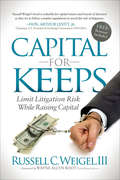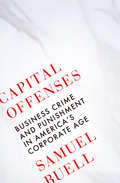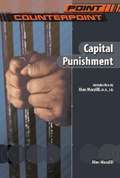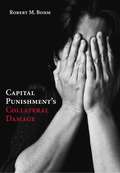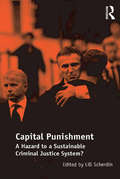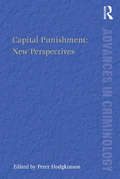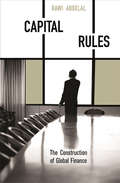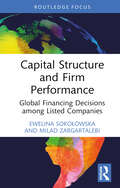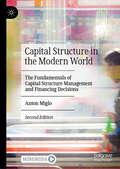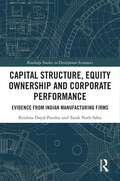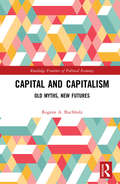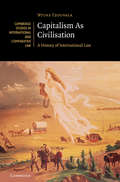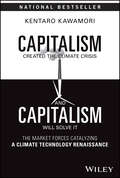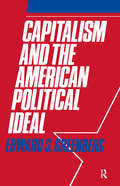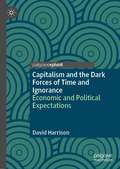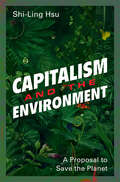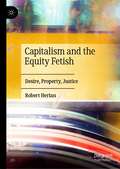- Table View
- List View
Capital Controls and International Economic Law (Cambridge International Trade and Economic Law)
by Bryan MercurioFocusing on capital controls, this study provides rigorous legal analysis to establish whether the mandate of the International Monetary Fund (IMF) extends to the capital account; that is, whether the IMF has the authority to control and/or regulate the use of capital controls by its member states. The book then analyses whether a country's use of capital controls is consistent with the obligations and commitments undertaken in various multilateral and bilateral trade and investment agreements. Finally, it analyses the tension within international economic law, as the IMF now encourages the use of capital controls under certain circumstances, while most trade/investment agreements prohibit or limit their use. Proposing a way forward to alleviate the tension and construct a more harmonious relationship between the norms and standards of finance, trade and investment, this study will be essential reading for policymakers.
Capital Defense: Inside the Lives of America's Death Penalty Lawyers
by Jon B. Gould Maya Pagni BarakThe unsung heroes who defend the accused from the ultimate punishmentWhat motivates someone to make a career out of defending some of the worst suspected killers of our time? In Capital Defense, Jon B. Gould and Maya Pagni Barak give us a glimpse into the lives of lawyers who choose to work in the darkest corner of our criminal justice system: death penalty cases. Based on in-depth personal interviews with a cross-section of the nation’s top capital defense teams, the book explores the unusual few who voluntarily represent society’s “worst of the worst.”With a compassionate and careful eye, Gould and Barak chronicle the experiences of American lawyers, who—like soldiers or surgeons—operate under the highest of stakes, where verdicts have the power to either “take death off the table” or put clients on “the conveyor belt towards death.” These lawyers are a rare breed in a field that is otherwise seen as dirty work and in a system that is overburdened, under-resourced, and overshadowed by social, cultural, and political pressures.Examining the ugliest side of our criminal justice system, Capital Defense offers an up-close perspective on the capital litigation process and its impact on the people who participate in it.
Capital Directive in Europe
by Dirk Van GervenThis book provides an overview of the Second Council Directive 77/91/EEC of 13 December 1976 (also known as the Capital Directive) and its implementing rules in each Member State of the European Union and the European Economic Area. It provides companies and advisors with useful insights regarding articles of association and related documents, the incorporation and capital requirements of European companies with limited liability and the rules applicable to the acquisition and pledge of their own shares, the cross-participations, the financial assistance and the distribution of profits. A general report on the Capital Directive is followed by a discussion of the implementation of the rules laid down in the Directive in the national laws of each Member State, each in accordance with a common format and contributed by a practitioner from that State.
Capital For Keeps: Limit Litigation Risk While Raising Capital
by Russell C. WeigelRaising Capital for Your Company or Your Real Estate Acquisition? Russell Weigel has been practicing securities law since 1990. For more than ten of these years he was an attorney for the Securities & Exchange Commission. Since 2001, he has been in private practice counseling public and private capital raisers and defending the securities industry and corporate executives from SEC and FINRA enforcement matters.Russell Weigel opens your eyes to the risks of raising capital but shows you a path to minimize these risks.Whether private or public, companies raising capital the wrong way and not properly planning for unforeseen events can result in substantial loss. Capital for Keeps is designed to save the entrepreneur thousands of dollars in legal fees by educating them on their options and the standards of conduct expected of them to stay away from the courthouse.
Capital Offenses: Business Crime and Punishment in America's Corporate Age
by Samuel W. BuellFrom the lead prosecutor on the Enron investigation, an eye-opening examination of the explosion of American white-collar crime. If “corporations are people too,” why isn’t anyone in jail? A serious defect in a GM car causes accidents; Enron scams investors out of their money; banks bet on the housing market crash and win. In the race to maximize profits, corporations can behave in ways that are morally outrageous but technically legal. In Capital Offenses, Samuel Buell draws on the unique pairing of his expertise as a Duke University law professor and his personal experience leading the investigation into Enron—the biggest white-collar crime case in U.S. history—to present an in-depth examination of business crime today At the heart of it sits the limited liability corporation, simultaneously the bedrock of American prosperity and the reason that white-collar crime is difficult to prosecute—a brilliant legal innovation that, in its modern form, can seem impossible to regulate or even manage. By shielding employees from legal responsibility, the corporation encourages the risk-taking that drives economic growth. But its special legal status and its ever-expanding scale place daunting barriers in the way of federal and local investigators. Detailing the complex legal frameworks that govern both corporations and the people who carry out their missions, Buell shows that deciphering business crime is rarely black or white. In lucid, thought-provoking prose, he illuminates the depths of the legal issues at stake—delving into fraudulent practices like Ponzi schemes, bad accounting, insider trading, and the art of “loopholing”—showing how every major case and each problem of law further exposes the ambivalence and instability at the core of America’s relationship with its corporations. An expert in criminal law, Buell masterfully examines the limits of too permissive or overzealous prosecution of business crimes. Capital Offenses invites us to take a fresh look at our legal framework and learn how it can be used to effectively discipline corporations for wrongdoing, without dismantling the corporation.
Capital Punishment (Point Counterpoint)
by Alan MarzilliEach book in this series offers all the statutes, legal opinions, and studies a student needs to structure a cohesive argument on a given controversial topic. Issues are presented from multiple points of view; sidebars cite law and opinions to aid in critical analysis; paratextual questions encourage reader engagement; and all sources are fully documented and grouped by the side of the argument. Explores the debates surrounding the death penalty: Is the state ever justified in taking a human life? How severe must a crime be to warrant the death penalty? Is capital punishment an effective deterrent to crime?
Capital Punishment and the Criminal Corpse in Scotland, 1740–1834 (Palgrave Historical Studies in the Criminal Corpse and its Afterlife)
by Rachel E. BennettThis book is open access under a CC BY 4. 0 license. This book provides the most in-depth study of capital punishment in Scotland between the mid-eighteenth and early nineteenth century to date. Based upon an extensive gathering and analysis of previously untapped resources, it takes the reader on a journey from the courtrooms of Scotland to the theatre of the gallows. It introduces them to several of the malefactors who faced the hangman's noose and explores the traditional hallmarks of the spectacle of the scaffold. It demonstrates that the period between 1740 and 1834 was one of discussion, debate and fundamental change in the use of the death sentence and how it was staged in practice. In addition, the study provides an innovative investigation of the post-mortem punishment of the criminal corpse. It offers the reader an insight into the scene at the foot of the gibbets from which criminal bodies were displayed and around the dissection tables of Scotland's main universities where criminal bodies were used as cadavers for anatomical demonstration. In doing so it reveals an intermediate stage in the long-term disappearance of public bodily punishment.
Capital Punishment's Collateral Damage
by Robert M. BohmThe literature on capital punishment is voluminous. For nearly 250 years, scholars have discussed and debated such issues as its deterrent effect, or lack thereof; retributive and religious arguments; costs; administration, including miscarriages of justice and whether it is imposed in an arbitrary and discriminatory manner; and whether methods of execution are cruel and unusual.
Capital Punishment: A Hazard to a Sustainable Criminal Justice System?
by Lill ScherdinAs most jurisdictions move away from the death penalty, some remain strongly committed to it, while others hold on to it but use it sparingly. This volume seeks to understand why, by examining the death penalty’s relationship to state governance in the past and present. It also examines how international, transnational and national forces intersect in order to understand the possibilities of future death penalty abolition. The chapters cover the USA - the only western democracy that still uses the death penalty - and Asia - the site of some 90 per cent of all executions. Also included are discussions of the death penalty in Islam and its practice in selected Muslim majority countries. There is also a comparative chapter departing from the response to the mass killings in Norway in 2011. Leading experts in law, criminology and human rights combine theory and empirical research to further our understanding of the relationships between ways of governance, the role of leadership and the death penalty practices. This book questions whether the death penalty in and of itself is a hazard to a sustainable development of criminal justice. It is an invaluable resource for all those researching and campaigning for the global abolition of capital punishment.
Capital Punishment: New Perspectives (New Advances in Crime and Social Harm)
by Peter HodgkinsonThis collection asks questions about the received wisdom of the debate about capital punishment. Woven through the book, questions are asked of, and remedies proposed for, a raft of issues identified as having been overlooked in the traditional discourse. It provides a long overdue review of the disparate groups and strategies that lay claim to abolitionism. The authors argue that capital litigators should use their skills challenging the abuses not just of process, but of the conditions in which the condemned await their fate, namely prison conditions, education, leisure, visits, medical services, etc. In the aftermath of successful constitutional challenges it is the beneficiaries (arguably those who are considered successes, having been ’saved’ from the death penalty and now serving living death penalties of one sort or another) who are suffering the cruel and inhumane alternative. Part I of the book offers a selection of diverse, nuanced examinations of death penalty phenomena, scrutinizing complexities frequently omitted from the narrative of academics and activists. It offers a challenging and comprehensive analysis of issues critical to the abolition debate. Part II offers examinations of countries usually absent from academic analysis to provide an understanding of the status of the debate locally, with opportunities for wider application.
Capital Rules: The Construction of Global Finance
by Rawi Abdelal"The rise of global financial markets in the last decades of the twentieth century was premised on one fundamental idea: that capital ought to flow across country borders with minimal restriction and regulation. Freedom for capital movements became the new orthodoxy. In an intellectual, legal, and political history of financial globalization, Rawi Abdelal shows that this was not always the case. Transactions routinely executed by bankers, managers, and investors during the 1990s—trading foreign stocks and bonds, borrowing in foreign currencies—had been illegal in many countries only decades, and sometimes just a year or two, earlier. How and why did the world shift from an orthodoxy of free capital movements in 1914 to an orthodoxy of capital controls in 1944 and then back again by 1994? How have such standards of appropriate behavior been codified and transmitted internationally? Contrary to conventional accounts, Abdelal argues that neither the U.S. Treasury nor Wall Street bankers have preferred or promoted multilateral, liberal rules for global finance. Instead, European policy makers conceived and promoted the liberal rules that compose the international financial architecture. Whereas U.S. policy makers have tended to embrace unilateral, ad hoc globalization, French and European policy makers have promoted a rule-based, “managed” globalization. This contest over the character of globalization continues today."
Capital Rules: The Construction of Global Finance
by Rawi Abdelal"The rise of global financial markets in the last decades of the twentieth century was premised on one fundamental idea: that capital ought to flow across country borders with minimal restriction and regulation. Freedom for capital movements became the new orthodoxy. In an intellectual, legal, and political history of financial globalization, Rawi Abdelal shows that this was not always the case. Transactions routinely executed by bankers, managers, and investors during the 1990s—trading foreign stocks and bonds, borrowing in foreign currencies—had been illegal in many countries only decades, and sometimes just a year or two, earlier. How and why did the world shift from an orthodoxy of free capital movements in 1914 to an orthodoxy of capital controls in 1944 and then back again by 1994? How have such standards of appropriate behavior been codified and transmitted internationally? Contrary to conventional accounts, Abdelal argues that neither the U.S. Treasury nor Wall Street bankers have preferred or promoted multilateral, liberal rules for global finance. Instead, European policy makers conceived and promoted the liberal rules that compose the international financial architecture. Whereas U.S. policy makers have tended to embrace unilateral, ad hoc globalization, French and European policy makers have promoted a rule-based, “managed” globalization. This contest over the character of globalization continues today."
Capital Structure and Firm Performance: Global Financing Decisions among Listed Companies (Routledge Focus on Economics and Finance)
by Ewelina Sokołowska Milad ZargartalebiIn the complex world of finance, understanding the relationship between a company's capital structure and its overall performance is crucial. This book offers a comprehensive exploration of the interdependence between capital structure decisions and business performance, with a specific focus on German-listed companies. It provides valuable insights into the intricate dynamics of corporate finance.Through a blend of theoretical frameworks, empirical research, and practical applications, the book presents readers with a thorough understanding of how capital structure decisions impact a company's profitability, risk profile, and long-term sustainability. From traditional theories of capital structure to cutting-edge empirical methodologies, the book outlines the latest developments in the field, offering practical tools and strategies for optimising financial decision-making. Moreover, the book explores how different regions and global trends influence capital structure decisions, providing a comprehensive examination of varying practices and the factors that shape them. It delves into specific aspects influencing global capital structures, including an analytical comparison of capital structures across key global markets such as the United States, the European Union, and China. This comparison highlights how economic, cultural, and market dynamics influence corporate leverage decisions. The impact of technological innovations and their role in reshaping financial strategies are also discussed.Designed for scholars, researchers, and advanced students in finance and economics, this book serves as a definitive reference for understanding the complex dynamics of corporate finance. With its rigorous analysis and practical insights, it equips readers with the knowledge and analytical tools needed to navigate the challenges of capital structure decision-making in today's dynamic business environment.
Capital Structure in the Modern World: The Fundamentals of Capital Structure Management and Financing Decisions
by Anton MigloThis book focuses on microeconomic foundations of capital structure theory. It combines theoretical results with a large number of examples, exercises and applications. The book examines fundamental ideas in capital structure management, some of which are still not very well understood in the business community, such as Modigliani and Miller&’s irrelevance result, trade-off theory, pecking-order theory, asset substitution, credit rationing and debt overhang. The second edition also covers capital structure issues related to recent developments in financial technology including crowdfunding and token issues and discusses significant differences between these innovative ways of firm financing compared to traditional debt and equity. Chapters also discuss the ways in which financial economists were forced to look critically at capital structure after the financial crisis of 2007-2009 and the COVID-19 pandemic, as the problems faced by many companies stemmed from their financing policies. Further the book analyzes links between capital structure and firm&’s performance, corporate governance, firm&’s strategy and flexibility, and covers such topics as life cycle approach to capital structure management, capital structure of small and start-up companies, corporate financing versus project financing and examples of optimal capital structure analyses for different companies. This comprehensive guide to capital structure theory will be of interest to all students, academics and practitioners seeking to understand this fast-developing and critical area.
Capital Structure, Equity Ownership and Corporate Performance: Evidence from Indian Manufacturing Firms (Routledge Studies in Development Economics)
by Tarak Nath Sahu Krishna Dayal PandeyThis book provides empirical insights into the relationship between capital and equity-ownership structure of Indian manufacturing companies and their financial performance. It discusses and analyses the basic theories and concepts associated with capital structure, debt financing, levered and unlevered firms, the various forms of ownership, agency problem and its kind and the exploitation of minority owners by the large and largest owners. The study employs a set of the most reliable and suitable econometric estimation techniques to draw meaningful inferences on the Indian manufacturing sector. The novelty of this book lies in three particular aspects: the depth and dimension with which the topic is addressed; the robust empirical evidence that it has produced and the simple and intelligible approach with which it is authored. It communicates the crucial relevance of corporate capital structure and equity-ownership to the moderation of agency relationship and shaping the internal governance mechanism, which ultimately results in increased or decreased operational efficiency and financial performance. It will enable readers to understand whether an increased amount of debt capital would bring about positive results for firms or create an extra burden on the management of their finances, preventing them from taking productive investment decisions due to the threat of liquidation. The book will find an audience among advanced students, scholars and researchers who are interested in understanding the corporate finance practices and governance mechanism of Indian organizations.
Capital and Capitalism: Old Myths, New Futures (Routledge Frontiers of Political Economy)
by Rogene A. BuchholzCapitalist societies need to undergo major change to provide for the material needs of all the people who work within the system, not just the 1 percent. They have become dysfunctional and need a different kind of orientation to continue in existence. Instead of creating wealth, which is what they are supposed to accomplish, they have created nothing but debt for the past several decades and are now in serious trouble with regard to finding the wherewithal to keep on functioning as viable societies that can provide job opportunities for their workers and the promise of a better life in the future for their citizens. The coronavirus pandemic has exposed just how many people live paycheck to paycheck and have not been able to accumulate any kind of savings. The 1 percent, meanwhile, have benefited greatly and have vastly increased their wealth over the past several decades. This book does not advocate the need to turn to a form of socialism, however, to give most workers a chance at a decent life for themselves. What is needed is a redefinition of capitalism to make it work for everyone. Capital and Capitalism seeks to uncover various myths about capitalism that hinder our ability to change the system and discuss the task of redefining capitalism by examining where neo-liberalism went wrong and what role restructuring the corporation along stakeholder lines can play in making capitalism more responsive to the entire society. It will be of interest to researchers, academics, and students in the fields of business and society, leadership, and business ethics.
Capital and Capitalism: Old Myths, New Futures (Routledge Frontiers of Political Economy)
by Rogene A. BuchholzCapitalist societies need to undergo major change to provide for the material needs of all the people who work within the system, not just the 1 percent. They have become dysfunctional and need a different kind of orientation to continue in existence. Instead of creating wealth, which is what they are supposed to accomplish, they have created nothing but debt for the past several decades and are now in serious trouble with regard to finding the wherewithal to keep on functioning as viable societies that can provide job opportunities for their workers and the promise of a better life in the future for their citizens. The coronavirus pandemic has exposed just how many people live paycheck to paycheck and have not been able to accumulate any kind of savings. The 1 percent, meanwhile, have benefited greatly and have vastly increased their wealth over the past several decades. This book does not advocate the need to turn to a form of socialism, however, to give most workers a chance at a decent life for themselves. What is needed is a redefinition of capitalism to make it work for everyone. Capital and Capitalism seeks to uncover various myths about capitalism that hinder our ability to change the system and discuss the task of redefining capitalism by examining where neo-liberalism went wrong and what role restructuring the corporation along stakeholder lines can play in making capitalism more responsive to the entire society.It will be of interest to researchers, academics, and students in the fields of business and society, leadership, and business ethics.
Capital without Borders
by Brooke HarringtonHow do the one percent keep getting richer despite financial crises and the myriad of taxes on income, capital gains, and inheritance? Brooke Harrington interviewed professionals who specialize in protecting the fortunes of the world's richest people: wealth managers. To gain access to their tactics and mentality, she trained to become one of them.
Capitalism As Civilisation: A History of International Law (Cambridge Studies in International and Comparative Law #142)
by Ntina TzouvalaMethodologically and theoretically innovative, this monograph draws from Marxism and deconstruction bringing together the textual and the material in our understanding of international law. Approaching 'civilisation' as an argumentative pattern related to the distribution of rights and duties amongst different communities, Ntina Tzouvala illustrates both its contradictory nature and its pro-capitalist bias. 'Civilisation' is shown to oscillate between two poles. On the one hand, a pervasive 'logic of improvement' anchors legal equality to demands that non-Western polities undertake extensive domestic reforms and embrace capitalist modernity. On the other, an insistent 'logic of biology' constantly postpones such a prospect based on ideas of immutable difference. By detailing the tension and synergies between these two logics, Tzouvala argues that international law incorporates and attempts to mediate the contradictions of capitalism as a global system of production and exchange that both homogenises and stratifies societies, populations and space.
Capitalism Created the Climate Crisis and Capitalism Will Solve It: The Market Forces Catalyzing a Climate Technology Renaissance
by Kentaro KawamoriCreative and practical free-market solutions to climate change In Capitalism Created the Climate Crisis and Capitalism Will Solve It: The Market Forces Catalyzing a Climate Technology Renaissance, distinguished author Kentaro Kawamori delivers a fascinating and timely exploration of the interplay between capitalism and climate change. He explains how the capitalist system helped to contribute to the current crisis of global warming and how that same system will help to end it. In the book, the author discusses the enormous impact of the climate crisis and how the government, the modern finance industry, the fossil fuel industry, and others combined to accelerate the warming of the world. He then considers the roles those same players will play to reverse this effect in the coming years. You’ll also find: Discussions of how climate tech innovations will transform the economy and how technology disruptors will become involved in the process The ways the energy industry will change to incorporate the realities and consequences of a warming climate Explorations of the incentives created by free market structures and how to include climate stakeholders in the discussionAn engaging and exciting new resource for anyone interested in the intersection of economics, business, and the environment, Capitalism Created the Climate Crisis and Capitalism Will Solve It contains practical and thoughtful climate prescriptions for a world desperately in need of them.
Capitalism and Climate Change: Theoretical Discussion, Historical
by Max KochThis book discusses climate change as a social issue, examining the incompatibility of capitalist development and Earth's physical limits and how these have been regulated in different ways. It addresses the links between modes of consumption, energy regimes and climate change during Fordism and finance-driven capitalism.
Capitalism and the American Political Ideal
by GrenbergThis practical handbook has been revised to provide in-depth coverage of the Office of Thrift and Supervision rules as well as those of the OCC. It includes up-to-date information on every of trust compliance, as it applies in 2000.
Capitalism and the Dark Forces of Time and Ignorance: Economic and Political Expectations
by David HarrisonThis book explores the role of expectations within the modern capitalist system. Through looking at how they are formed and develop, the impact of events that lead to a collapse in expectations, such as a major financial crisis, is examined to highlight the precarious and unstable nature of the economic system. With a particular focus on the UK and USA, it is also considered how public policy and institutions can shift the balance away from speculation and back towards enterprise. This book aims to conceptualise instability and highlight how economic and regulatory policy can limit it. It will be relevant to researchers and policymakers interested in economic policy and regulatory reform.
Capitalism and the Environment: A Proposal to Save the Planet
by Shi-Ling HsuRising economic inequality has put capitalism on trial globally. At the same time, existential environmental threats worsen while corporations continue to pollute and distort government policy. These twin crises have converged in calls to revamp government and economic systems and to revisit socialism, given up for dead only 30 years ago. In Capitalism and the Environment, Shi-Ling Hsu argues that such an impulse, if enacted, will ultimately harm the environment. Hsu argues that inequality and environmental calamities are political failures – the result of bad decision-making – and not a symptom of capitalism. Like socialism, capitalism is composed of political choices. This book proposes that we make a different set of choices to better harness the transformative power of capitalism, which will allow us to reverse course and save the environment.
Capitalism and the Equity Fetish: Desire, Property, Justice
by Robert HerianThis book is a provocative, interdisciplinary, and critical appraisal of civil justice, property, and the laws that shape and command them within capitalism. Dr. Herian’s book is both a complementary and countervailing narrative to many mainstream legal accounts, one that critiques core and influential areas of legal knowledge and practice. Central to the book’s thesis is a rich collaboration of ideas and perspectives that consider what is at stake from institutions, concepts, and practices of equity and civil justice tied to the subjective psychic life and the unconscious desires of capitalist stakeholders. The book aims to address several questions, including how capitalism has imagined and shaped equity and civil justice since the nineteenth century; how capitalism acts as a well-spring of desire for forms of justice that wrap-around and sustain complex frameworks of private property power and ownership; and how equity supports agile neoliberal strategies of justice and reason in the twenty-first century.



